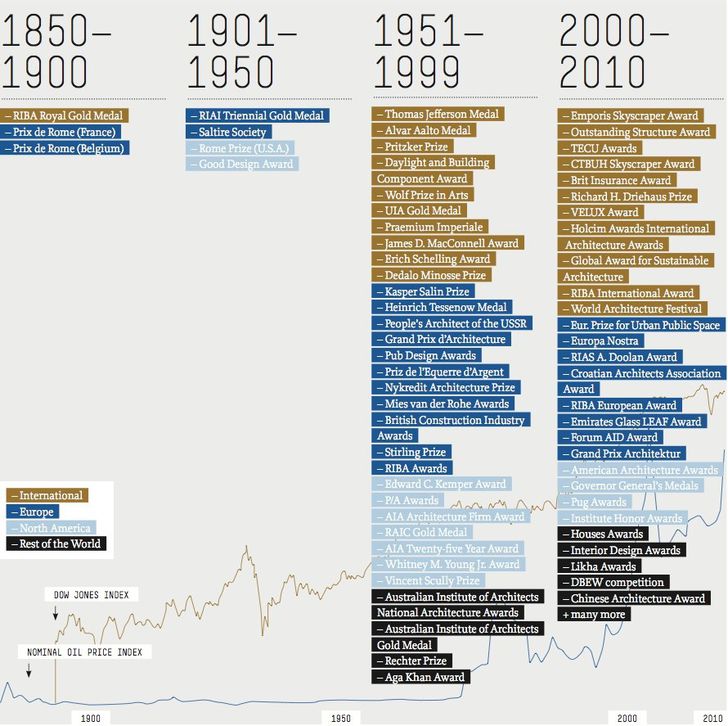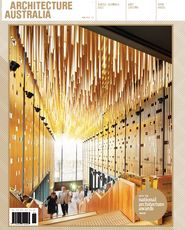This issue of Architecture Australia is dedicated to award winners and, in particular, the recipients of the 2011 National Architecture Awards.
The increasing number of award programs across the globe (captured in Simon Pennec’s diagram below) prompts the question: what does a peer-driven awards program mean today? To respond to this question once again in Architecture Australia, the National Architecture Awards mean everything. They are a chance to share in a collective tradition with colleagues, and a tradition where projects are visited and experienced by a group of peers rather than a best-of, top-five or televoted result rated from a single sound bite, hero image or alpha personality (see Rachel Hurst’s In Response). The awards are the ultimate recognition of architecture in this country.

Simon Pennec’s diagram marking out the commencement of various awards against economic growth.
Among these award-winning projects, however, there is no unbuilt vision, no policy to advance architecture, no award of ambition (see Rory Hyde’s In Response). The notion of what makes good architectural work is not only an eternal question for the awards program, but a wider problem of thinking about architecture in this nation. It is rare that a major cultural prize for architecture is awarded in Australia. Art, scholarship and science take priority (after sport), while commercial or government subsidies, sponsorship and support are handed out to solve problems in the built environment rather than actual built work – such as public works created by open competitions (see OpenHAUS). In light of this, the National Awards are one of a kind.
There are also other winners to mention this year. If you’ve survived a global financial crisis – twice – then you are definitely one of these, as it means that you have managed a phalanx of risks. There is the risk of cash flow failure, design fault, problems with anonymous bureaucracy, client abscondment and breakdown within the consultancy team. All of these scenarios come back on the individual architect and it’s no wonder there is a high risk aversion: in the face of this great risk, the act of building can be immobilizing. One could fail if risk is not taken into account.
To be a winning architect, though, is not only a matter of smooth risk management. It is also about taking a risk. To take a risk means that we are not victims of circumstance, nor rolling with the punches. By taking a giant leap into the unknown, an individual can lead and advance their cause (see Bart Lootsma). And this leap of faith can be acted out with other like-minded people. By making risk a collective problem, a new constellation of actors can be formed, an economy of scale may be met, and innovation can arise through this collaboration.
But there is a catch, of course. To take a giant leap hinges upon the fact that architects have authority in building making, that architects possess unique and needed expertise in spatial design, that architects hold power and influence in the city and, more importantly, that the architect is equipped with the chutzpah and swagger to believe in all of the above.
When you glance over the award-winning architecture within this issue, remember that you are also involved in the risky endeavour of making architecture. By reading this magazine, you believe in the contribution architecture can make to the environment. And you are also the judge of architecture because all of our definitions of what good architecture can be are pointedly different – “we all have our top fives,” says Rachel Hurst – because there is no real way to calculate the parameters of architecture, and the risk of making a building. The one thing we can agree upon is the recognition of architecture.
Timothy Moore, editor of Architecture Australia.
Source

Archive
Published online: 9 Feb 2012
Words:
Timothy Moore
Issue
Architecture Australia, November 2011














